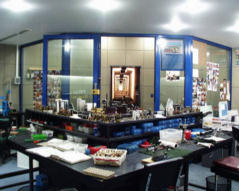

 The Accurate Reloading Forums
The Accurate Reloading Forums  THE ACCURATE RELOADING.COM FORUMS
THE ACCURATE RELOADING.COM FORUMS  Guns, Politics, Gunsmithing & Reloading
Guns, Politics, Gunsmithing & Reloading  Reloading
Reloading  References wanted: The theory of internal combustion
References wanted: The theory of internal combustionGo  | New  | Find  | Notify  | Tools  | Reply  |  |
| one of us |
/ | ||
|
| One of Us |
You can easily find large tomes on interior ballistics. You may not want that much detail. Perhaps some questions to the forum about specific loading questions will help you more. I tend to refer to the reloading manuals that show pressure figures as well as velocity for my starting loads. I shy away from loads that show high pressures when there is a powder that gives about the same velocity with lower pressure. I just recently did that research for the 7.62x39 and came up with AA1680, WC680, AA2460 and AA2230 as reasonable powders. You can then find out where your powder falls in the burn rate range as compared to known reasonable powders to decide if you want to do any load development with that powder. I guess my answer to your question is that I leverage other people's work by using loading manuals. I am a mathematician and can handle the complexities of interior ballistics but I see very little practical reason to do so. Throw out some specific questions and the forum will help you. RELOAD - ITS FUN! | |||
|
| one of us |
ALF, There is a collection of articles, most written by Lloyd E. Brownell, Ph.D., from September 1967 through April 1971 in Handloader magazine. These and a few others are collected in a book put out by Wolfe Publishing in 1990. It is out of print now. I got my copy in a round about way from the Sno-Isle Regional Library System in Marysville, WA. It was withdrawn from the system because of the subject matter. Let's hear it for censorship and book burning. I'll mail you the contents pages. You can print the articles off of your CD-ROM of all the Handloader issues.  | |||
|
| one of us |
Homer Powley did a lot of work in this area. He worked specifically with the IMR powders, but you can interpolate with orther powders of similar construction and burn rates. I believe his formulae break down a bit at either extreme of case size and burning rate, but don't have the relevant articles handy. Some of the best material is classified, and resides at Yuma, AZ, and Natick, MA.  | |||
|
| one of us |
Isn't this a $350 item ? I find modern handloading books are a must for the handloader, but they do not give much more than a basic feel for interior ballistics. Brownell and Powley (have a search for "Powley computer") dig much deeper. Unfortunately they are no more available staight away - as Sharpe and Naramore. An extremely good publication to get into this topic is E.D. Lowry's Internal Ballistics - unfortunately it is even more difficult to obtain. As one of the posters warns that real access to interior ballistics needs more than a basic education in maths (and yes, he is absolutely right)- the a.m. authors try to torture their readers with as little as possible with this kind of stuff. For antique books search I use the very powerful www.sfb.at - don't shy away from the German: it's easy to use and flips to English, if memory serves. ----------------------------- Too bad the only people who know how to run the country are busy driving cabs and cutting hair. ~George Burns | |||
|
| one of us |
alf, I'd be glad to explain it, but I'm sure you wouldn't understand it. Plus I know you would fill the thread with blatherskite. | |||
|
| one of us |
[/ | |||
|
| one of us |
Interestingly enough, I don't believe their is a specific absolute quantification of burn rate. It is generally expressed as a scale of relative rates with a given powder under specific conditions given an arbitrary value of 100, and all other powders assigned a relative value (see the most recent edition of the VihtaVouri manual). A more useful way of looking at a given powder is its burning/pressure time curve. Various powders burn in a progressive, linear or degressive pattern. Since the "new nitro" cartridges were introduced from (about) 1894 - 1928, along with the various new powder formulations, I believe the specific mass of the bullets for various chamberings was determined empirically. Notice how the bullet weights and velocities changed quite often during the formative years of the 303, 7x57 and 30-06 cartridges. With each advance in powder, the bullet form and weight was changed to improve performance. If you can come up with a title for the older book, I may be able to find a copy in a university library. Washington University in St. Louis and the University of Chicago both have extensive German Language titles in the chemistry and physics sections of their reseach libraries. A lot of the basic texts are archived at the aeroballistics labs at Sandia National Laboratories/Kirkland AFB. Good luck accessing them though. I was stupid at the university. I should have studied German, but I took a bunch of courses in Chinese, which is useless to me. I wish I was fluent in German right now. LD  | |||
|
| one of us |
Google needed 10 seconds to come up with a printed source: http://www.astronautix.com/astros/woldemar.htm But the two German books on Innere Ballistik are not by him; he published on rocket ballistics and on probability applied to bullet dispersion. Edit: I was wrong. See ALF's correction and my follow-up below. Carcano -- "Those who sacrifice liberty for security deserve neither." "Is the world less safe now than before you declared your Holy war? You bet!" (DUK asking Americans, 14th June 2004) | |||
|
| One of Us |
AKIN TO THIS IS WHAT CRITERIA WAS USED IN 1892 TO CREATE THE 7X57, A PERFECT CARTRIDGE? THEN, WHY WAS THE 8x57 DEVELOPED WHEN THE 7X57 WAS PROVEN TO BE SO EFFECTIVE? | |||
|
| one of us |
The "Quickload" manual by Helmut Broemel also describes the formulas used in the simulations by the program, and quantifies the parameters used for each powder in the database. HTH, Dutch. Life's too short to hunt with an ugly dog. | |||
|
| one of us |
/ | |||
|
| one of us |
You are right, I was wrong. The book is indeed so listed in the online catalog of the Deutsche Nationalbibliothek Leipzig. It never had been reprinted or seen 2nd and 3rd and 4th editions, as his better-known book on rocket ballistics. Again, mea culpa. Thanks, Carcano -- "Those who sacrifice liberty for security deserve neither." "Is the world less safe now than before you declared your Holy war? You bet!" (DUK asking Americans, 14th June 2004) | |||
|
| one of us |
I recently traded a copy of Brownells "Firearms Pressure Factors" for an old Remington typewriter we had. It is a very good work. | |||
|
| one of us |
/ | |||
|
| one of us |
ALF, Dr. Ken Oehler discusses his work on the CUP/PSI conversion in the current issue of "Rifle Shooter" (IIRC). You might write him for a copy of his paper? HTH, Dutch. Life's too short to hunt with an ugly dog. | |||
|
one of us |
The question ought to be turned around. The 8x57 cartridge was adopted as Germany's military standard in 1888, 4 years before the 7x57 came out. And the 8x57 is a mighty effective and versatile cartridge. "A cheerful heart is good medicine." | |||
|
| one of us |
/ | |||
|
| Powered by Social Strata |
| Please Wait. Your request is being processed... |
|
 The Accurate Reloading Forums
The Accurate Reloading Forums  THE ACCURATE RELOADING.COM FORUMS
THE ACCURATE RELOADING.COM FORUMS  Guns, Politics, Gunsmithing & Reloading
Guns, Politics, Gunsmithing & Reloading  Reloading
Reloading  References wanted: The theory of internal combustion
References wanted: The theory of internal combustion

Visit our on-line store for AR Memorabilia

